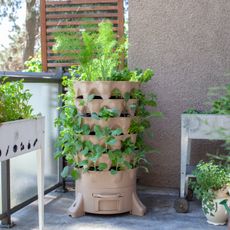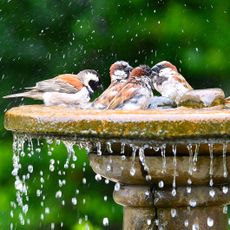How To Create A Newt Habitat For Exotic Garden Wildlife
If you create a newt habitat, you’ll give your wildlife garden a boost while making friends with some highly engaging animals. We show you how easy it is to make room for newts


A newt habitat is a perfect chance to get acquainted with some highly engaging and intriguing creatures. Newts are a kind of salamander, distinguished by their semi-aquatic lifestyle. These small amphibians spend part of their lives on land, and part in the water.
While there are over 100 species of newts living in North America, Europe, Africa and Asia, they metamorphose in the same way. They start life as larvae living in water like freshwater ponds, marshes or small lakes. They move to land for their juvenile stage (when they are termed efts) and stay on land as adults, returning to water only to breed.
Newt populations are in trouble in many regions. This is primarily a result of habitat loss, with pollution a close second. You can help mosquito-munching newts thrive in your yard if you create a newt habitat. It’s not difficult to put in a newt pond, an essential part of a newt habitat setup. I’ve had one for years, and can testify that it doesn’t require much effort to keep these amphibians happy!

Essentials for Creating a Newt Habitat
For newts to live and thrive, they need a proper newt habitat. This will necessarily include a small, freshwater pond or marsh. The terrestrial area is where newts live as they grow older. It should be rich in cover, including cultivated ground cover. There should also be yard detritus like fallen leaves and brush piles for your newts.
The best habit for newts will have shelter. They spend a good part of their lives on land, but the best habitat for newts includes moist, decaying logs and stumps. They visit this sheltered area when they are hiding from predators or need protection from the elements.
How to Create a Newt Habitat
Many gardeners might need to add a water element if they want to attract newts to garden areas. This can (but need not) be a large body of water. You can either hire a contractor or dig your own pond. Vary the depth of your pond or water feature, so some areas are deeper than others. If you use a liner, cover it with mud (organic, not fertilized topsoil) and dead leaves to provide cover for the newts.

Making Sure Newts Are Safe and Happy
Newts consume aquatic insects, such as mosquitos. This generally is not a problem, since anyone who adds a pond to their backyard is likely to have mosquitos. Be sure not to use any toxic or chemical sprays that could get into the water and kill the newts.
Gardening tips, videos, info and more delivered right to your inbox!
Sign up for the Gardening Know How newsletter today and receive a free download of our most popular eBook "How to Grow Delicious Tomatoes."
I have had a backyard pond for years. These amphibian friendly environments are great for attracting newts, salamanders, frogs, dragonfly larva, toads and snakes in the water. However, take care with wood. Early on, I added a piece of wood for a bridge and sunning area. I put in cut lumber that had been pre-treated. The next morning, I woke to find many dead amphibians. It was a sad moment, but a good lesson. Use natural wood and look out for anything that might have been sprayed or treated.
Another danger for newts is the domestic cat. Cats may be wonderful pets indoors, but outdoors they can be killing machines. They prey on birds, but can also kill amphibians. Don’t let your cat roam outdoors.
Also, don’t get too deeply involved in the newt’s personal lives. Once my young daughter spotted a newt that appeared to be acting aggressively toward a smaller newt. I stepped in and chased it away. I later learned that this was a ritual mating dance, not an act of amphibian bullying.
Choose The Right Plants For a Newt Habitat
Native plants are best for all forms of wildlife, and this includes newts. The plants that typically grow wild in your area will attract the native insects that the newts are used to consuming. For an effective newt habitat setup, one tip I found helpful is to take out the lawn. Lawns have no value when it comes to wildlife habitat. Instead, put in native grasses which not only help amphibians, but also birds, small mammals and even deer.

Which Visitors Come To a Newt Habitat
The types of newts your newt habitat will attract depends on where you live. But wherever, there are likely to be other visitors as well. In my backyard pond in France, we regularly get tadpoles, young toads, young collar snakes and dragonfly larva. Most of these creatures are carnivorous and eat mosquitos, too! The snakes also eat tadpoles and young newts, but you have to let nature take its course.
Frequently Asked Questions
Can Newts Live with Turtles?
If you also wish to attract turtles to your garden, take care with newts. Newts and turtles don’t make good roommates. The turtle may well eat the newt and, given the toxicity of its skin, both creatures can die. In addition, turtles prefer water that is much warmer than what newts like, so one or the other species will suffer.
Can Newts Live with Fish?
It is not a good plan to put fish into your newt pond. Fish eat a lot of eggs from newts and other salamanders. As they grow, the young newts have to move around a lot to find mosquitos to eat, so they become easy fish prey.

Teo Spengler has been gardening for 30 years. She is a docent at the San Francisco Botanical Garden. Her passion is trees, 250 of which she has planted on her land in France.
-
 Clever Vertical Vegetable Garden Ideas For Small Spaces – 7 Ways To Save Space
Clever Vertical Vegetable Garden Ideas For Small Spaces – 7 Ways To Save SpaceShort on garden space? Learn some vegetable garden ideas for small spaces that are fun and easy.
By Mary Ellen Ellis
-
 26 Different Types Of Orchids – With Pictures & Information
26 Different Types Of Orchids – With Pictures & InformationDiscover stunning orchid types to grow in your home and garden – from easy beginner varieties to rare and exotic species that are the preserve of experts.
By Melanie Griffiths
-
 Landscaping Around A Fire Hydrant: Landscaping Tips And Safety Considerations
Landscaping Around A Fire Hydrant: Landscaping Tips And Safety ConsiderationsIt might not sound like the obvious choice for a landscaping project, but a fire hydrant can work with a bigger gardening vision. Follow our tips on landscaping around a fire hydrant
By Mary Ellen Ellis
-
 Planting For Chickens: Why You Should Plant A Chicken Garden
Planting For Chickens: Why You Should Plant A Chicken GardenIf you’ve never considered planting for chickens, this is your chance to enjoy their joyful benefits. We show you how to make an easy chicken garden
By Amy Grant
-
 Why It's Time To Raise Ducks For The Garden – Move Over, Chickens!
Why It's Time To Raise Ducks For The Garden – Move Over, Chickens!Others might call you quackers, but if you get some ducks for the garden, you can enjoy a host of plot-friendly benefits. Just follow our expert guide to make the most of these unique creatures
By Mary Ellen Ellis
-
 Dark Home Exterior? Choose The Right Plants With Our Expert Dark House Landscaping Tips
Dark Home Exterior? Choose The Right Plants With Our Expert Dark House Landscaping TipsIf the front or back of your house is very dark, what are the implications for the plants you grow? We reveal how understanding dark house landscaping can help you pick the right plants
By Susan Albert
-
 Best Plants For Frogs: 7 Plant Varieties To Bring More Froggies To Your Yard
Best Plants For Frogs: 7 Plant Varieties To Bring More Froggies To Your YardA frog-friendly environment is one of the key indicators for garden health – so if you want to improve the health of your plot, here are seven plants for frogs you need to try
By Janey Goulding
-
 Support Your Area's Pollinators By Using Keystone Plants
Support Your Area's Pollinators By Using Keystone PlantsAn understanding of keystone plants is not just a great way to make sure your garden is as enticing as possible to pollinators – it’s critical for the future of key species. We show you how to raise your eco-awareness
By Teo Spengler
-
 Plant Hacks On TikTok That Are Actually Worth Trying
Plant Hacks On TikTok That Are Actually Worth TryingYou may have come across a few plant hacks online and wondered how many are worth your time. We round up the key plant hacks on TikTok that are every bit as good as they claim to be…
By Mary Ellen Ellis
-
 Don’t Make These 5 Bird Bath Mistakes If You Want More Birdies!
Don’t Make These 5 Bird Bath Mistakes If You Want More Birdies!Love your birdlife but failing to entice many feathered visitors? Check your backyard’s bathing facilities and make sure you avoid these classic bird bath mistakes
By Janey Goulding